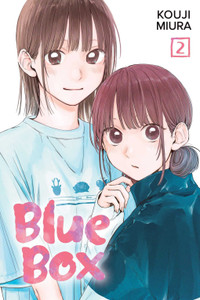Review
by MrAJCosplay,Blue Box
GN 2
| Synopsis: |  |
||
Taiki Inomata loves badminton but has a long way to go before he can reach nationals. When Taiki sees upperclassman Chinatsu Kano practicing her heart out on the girls' basketball team, he falls for her hard. After an unexpected turn of events brings the two closer together, sports might not be the first thing on their minds anymore! Taiki's new doubles partner puts him on an intense training regimen that makes his dream of reaching nationals start to feel a little more achievable. Then Taiki meets another badminton player with eyes for Chinatsu. Will this new rival spell the end for Taiki's romantic aspirations? Blue Box GN 2 was translated by Christine Dashiell with lettering by Mark McMurray. |
|||
| Review: | |||
Blue Box is a manga that exists in that sweet spot between a well-paced slice-of-life romance and a traditional sports story. While the series doesn't reach the massive highs that either of those genres has to offer, the two feed into each other enough to create a mostly enjoyable experience. In volume one, we were introduced to Taiki and how the unique circumstance of his trying to get closer to Chinatsu parallels his motivation to be a better badminton player. Add in the spice of his senpai living in his house, and you have a relatively simple yet solid setup. That said, volume two doesn't hyper-focus on the idea of these two adolescents living under the same roof. While the book doesn't ignore that setup, it's more of a convenient excuse for our two leads to be alone together outside of a school setting. Most of the book takes place outside the home, either at school or, more specifically, on the badminton court. While volume one introduced us to Taiki and Chinatsu's relationship, volume two seems more interested in expanding the main cast with other students at school. We get to see a little more of Taiki's best friend, Kyo, being a good source of moral support. We get introduced to Haryu, who not only represents a ladder for Taiki to climb but also acts as a fun source of support in a surprisingly clever way. However, the person who probably represents the heart of this volume is Hina, a gymnast friend of Taiki who also established herself as a pillar of support. While the book arguably goes in a rather typical direction with her character, I do want to give credit that how she emotionally gets from point A to point B by the end was surprisingly well handled. It's more of a gradual change over time than the usual sudden romantic shift we see in many other stories, and it ties into her insecurities in a way that acts as a subtle mirror for Taiki. The way the character was written regarding her feelings of envy and the pressures she feels from her sport were all handled exceptionally well. She's probably the character with the most depth in the story outside Taiki. But that does bring me to one of the downsides of the volume that I feel carries over from the previous one, and that's the fact that Chinatsu, who is supposed to be our second protagonist, struggles to come off as a character in her own right. There are some interesting conversations between her and Taiki regarding their ambitions and how they view things. However, we don't get in her head nearly as much as we do with Taiki, making their dynamic feel one-sided. With Taiki, it feels like we're watching the story of what used to be a rather aimless teenager finding motivation in other people and the strength to focus on a concrete goal. The book sometimes can't decide how much of his motivation comes from genuine self-improvement or his romantic affections, but his character is clear and straightforward most of the time. Chinatsu has moments where she will comment or react to somebody else or a particular situation, and the book's presentation does an excellent job of implying a lot of introspection. This book's artwork is far more expressive and dynamic than in the previous volume, with softer establishing shots and more dynamic badminton matches. However, that implied introspection could also be because I was starved for more characterization from Chinatsu. The conversations that we do get aren't bad. Still, they are incredibly simple, and it might make the character come off as more of a goal to achieve rather than someone who has her own wants and determination in a series that heavily stresses bettering yourself for the sake of a specific purpose. Despite that, the volume does enough for me to consider it a proper follow-up to the foundation set up in book one. While I would've liked more characterization from Chinatsu, Taiki continues on a mostly believable path. The artwork is more expressive and involved than before, which helps make up for any of the book's shortcomings. Plus, while I was surprised by the book's focus on other characters, their integration into the story was undoubtedly appreciated by the end. Here's hoping that what follows continues to surprise me. |
| Grade: | |||
|
Overall : A-
Story : B+
Art : A
+ Artwork is a step up from before, side characters are given more to do, Hina's progression throughout the volume give the volume a lot of heart |
|||
| discuss this in the forum (1 post) | | |||
| Production Info: | ||
|
Full encyclopedia details about |
||